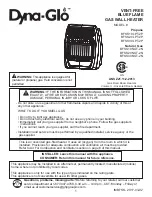
19
Discharge Pipe work
It is a requirement of Building Regulations that any discharge from an unvented system is
conveyed to where it is visible, but will not cause danger to persons in or about the building. The
tundish and discharge pipes should be fitted in accordance with the requirements and guidance
notes of Building Regulations. Building Regulation G3 Requirements and Guidance section 2
(page 17) are reproduced in the previous sections.
For discharge pipe arrangements not covered by G3 Guidance advice should be sought from
your local Building Control Officer. Any discharge pipe connected to the pressure relief devices
(Expansion Valve and Temperature / Pressure Relief Valve) must be installed in a continuously
downward direction and in a frost free environment.
The water may drip from the discharge pipe of the pressure relief device and that this pipe must
be left open to the atmosphere. The pressure relief device is to be operated regularly to remove
lime deposits and to verify that it is not blocked.
G3 Requirement
“...there shall be precautions...to ensure that the hot water discharged from safety devices is
safely conveyed to where it is visible but will not cause danger to persons in or about the building”.
Worked example of discharge pipe sizing (Taken from Building Regulations 2000, G3,
2010 edition)
The example below is for a G1” temperature relief valve with a discharge pipe (D2) having 4 No.
elbows and length of 7m from the tundish to the point of discharge.
From Table 5:
Maximum resistance allowed for a straight length of 35mm copper discharge pipe (D2) from a
G1” temperature relief valve is 9m.
Subtract the resistance for 4 No. 35mm elbows at 1.4m each = 5.6m
Therefore the permitted length equates to: 3.4m
3.4m is less than the actual length of 7m therefore calculate the next largest size.
Maximum resistance allowed for a straight length of 42mm pipe (D2) from a G1” temperature
relief valve equates to 18m.
Subtract the resistance of 4 No. 42mm elbows at 1.7m each = 6.8m
Therefore the maximum permitted length equates to: 11.2m
As the actual length is 7m, a 42mm (D2) copper pipe will be satisfactory.
Warnings
1.
Under no circumstances should the factory fitted Temperature /Pressure Relief Valve be
removed other than by authorised Heatrae Sadia personnel. To do so will invalidate any
guarantee or claim.
2.
The Cold Water Combination Valve must be fitted to the mains water supply to the Andrews
Flexistor unit.
3. No control or safety valves should be tampered with or used for any other purposes.
4. Water may drip from the discharge pipe of the pressure relief device (Expansion Valve) and
this pipe must be left open to atmosphere. The discharge pipe should not be blocked or used
for any other purpose.
5. The tundish must be installed so that it is visible to the end user.
6. The tundish and drain valve must be installed away from any electrical components.
7.
No valve should be fitted between the 8 bar or 13 bar pressure relief valve and the Andrews
Flexistor unit.
Summary of Contents for Flexistor 1000
Page 30: ...30 38 Part No 95 607 690 46 Part No 95 980 009 2 1 34 1 46 ...
Page 31: ...31 48 38 30 38 31 32 ...
Page 32: ...32 ...
Page 33: ...33 ...
















































